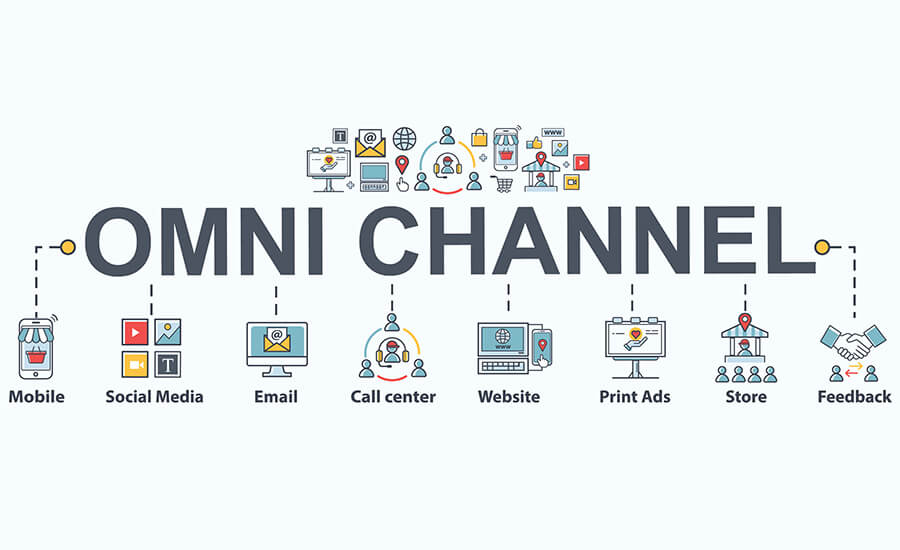
Omnichannel. You’ve undoubtedly heard and read this phrase a lot. In sales meetings, or on your favorite marketing blog. You may even say it yourself now and again. However, when the term is used so often, it may be difficult to understand what individuals mean. In this blog article, we’ll explain what omnichannel is. finally and for all. Also, distinguish between omnichannel, multichannel, and single-channel commerce. Discover what omnichannel means for your company now and in the future.
Table of Contents
What is Omnichannel Marketing?
The integration of a company’s marketing channels to offer consumers a smooth, unified brand experience is known as omnichannel marketing. The aim of omnichannel marketing is to connect consumers meaningfully regardless of time, device, or channel, and to create a unified experience that encourages customers to take action, whether on a mobile device, desktop computer, or in a physical shop.
Omnichannel is more than just a marketing term; it signifies a significant change in how companies handle consumer contacts in response to a changing business environment. The consumer journey is no longer a straight line. A purchase prompted by a social media post may be followed by online research on a PC and finished on a tablet or at a physical shop.
Overall, the advantages of effectively adopting omnichannel marketing strategies include improved customer experience, increased customer retention, and more visibility into the customer lifecycle for companies. Omnichannel marketing is an approach to multichannel marketing, but it is not multichannel marketing. However, omnichannel marketing is sometimes referred to as a more advanced level of multichannel marketing. While both methods seek to engage with the audience via various channels, the main emphasis differs significantly. The emphasis of multichannel marketing is on the brand, while the focus of omnichannel marketing is on the consumer.
What is Omnichannel Attribution?
In an age where there are numerous touchpoints across platforms, who should be credited with the conversion? Without a proper attribution strategy in place, marketers may find it impossible to respond. Marketers often depend on multi-touch attribution and media mix modeling (MMM) to determine what contributed to a conversion; nevertheless, these models are not without flaws.
- MMM stands for Media Mix. Modeling only considers long-term aggregate data, rather than individual-level insights. While this enables marketers to monitor the effect of a campaign on conversions as well as historical patterns such as times of the year when consumers increase or decrease interaction, it does not offer insight into individual preferences. MMM also utilizes data from many years ago, which means that teams cannot use this model to improve ads in real-time.
- MTA: Multi-touch attribution provides detailed, person-level data across each touchpoint in real-time. After analyzing the data, teams may utilize it to make adjustments to ads as they run in order to better cater to customer requirements. The difficulty with multi-touch attribution is determining how much credit each touchpoint should be given for a conversion. For example, was the webinar or the email campaign more effective in influencing the customer to convert?
Attribution models no longer need to depend on antiquated methods and may now provide a more comprehensive picture of the marketing funnel and the buyer’s journey. Similar to how omnichannel strategies integrate online and physical channels, omnichannel attribution breaks through barriers between campaign metrics to identify the impact each touchpoint had on the trip.
Personalization in Omnichannel Commerce
Your consumers anticipate a customized experience across all channels and touchpoints. Today’s customers demand not just high-quality goods, but they also want them promptly and with as much information as possible. They want to be able to go to your website and quickly search for goods, compare prices, and get personal recommendations.
Personalized content manages to pique the attention of customers in the midst of an information overload. While all other information is thrown at them and disregarded, customized content speaks directly to them. It has become even more important to provide customized experiences to your customers since 74 percent of online consumers get dissatisfied with websites when material that has nothing to do with their interests shows, and frustrated shoppers do not purchase. As a result, customization is no longer a nice-to-have, but rather a must-have for today’s companies.
How Does The Store Fit Into An Omnichannel Strategy?
While ecommerce is expanding, retail continues to play an essential part in customers’ lives. Despite the fact that the function of the store is changing, a significant proportion of customers still choose to buy in physical shops rather than online. Both merchants and consumers are beginning to see the store’s potential as a showcase and supplier of tailored experiences.
In-store events are becoming more popular as a way for retailers to engage with their customers – think seminars, competitions, and lessons, meet-ups with brand champions and influencers, and product demos. They are also using their floor space as a brand display since it offers a physical, sensory purchasing experience that the internet world just cannot equal. So brick-and-mortar stores have a future; they simply need to be smoothly integrated with a company’s other channels.
An omnichannel approach, in theory, helps companies by connecting their physical and online channels and strengthening their strengths, making them stronger than they would be on their own.
Five Reasons Why Businesses Are Adopting An Omnichannel Strategy
1. Improve Customer Lifetime Value
An omnichannel experience prioritizes the consumer, and it’s no surprise that customers want to do business with companies that put them in control. It is therefore unsurprising that retail executives place a premium on long-term objectives. According to the Coresight study, 53 percent of top European retailers believe that increasing lifetime customer value is a justification for adopting an omnichannel strategy, whereas only 34 percent of other retailers agree.
2. Reach New Customer Segments
Businesses profit from an omnichannel approach because it allows them to access new consumer groups. This advantage is almost equally significant to both top retailers and ‘others’ (48 percent vs. 45 percent), but both figures should be higher since accessing new consumers is critical to growth.
3. Increase Operational Efficiency
Businesses may experience improved operational efficiency and cost savings as a result of implementing an omnichannel strategy. Businesses that use an omnichannel approach only need to gather a customer’s data once, rather than at each touchpoint. Creating a comprehensive perspective also eliminates the need for businesses to worry about developing and executing plans for each channel.
4. Increase Sales
Increased sales are a fantastic advantage for merchants that need to increase their income. According to Harvard Business Review research, multichannel clients spend 10% more online than single-channel customers. However, top merchants (42 percent) are not as focused on this as ‘others’ (57 percent ). Leading retailers clearly prioritize long-term success and see the advantages of an omnichannel approach as strategic and structural.
5. Improve Inventory Turnover
The days of businesses losing revenue due to out-of-stock goods may be coming to an end. Businesses benefit from an omnichannel approach because it gives them a greater perspective of their inventory and the flexibility to fulfill orders from anywhere. Businesses may use an omnichannel approach to optimize stock levels and create better replenishment processes.
Five Benefits of Omnichannel Every SMB Should Take Advantage Of:
1. High Customer Retention and Loyalty
Customers will always purchase from a brand they know and trust. Omni-channel marketing ensures a uniform user experience across many platforms. Each platform offers a distinct and customized message for each customer (remember the previous Sushi vendor?)
2. Smoother Customer Journey
Understanding how consumers act as they go through your sales funnel will undoubtedly enhance performance and reduce drop-out points in the consumer’s journey.
3. Instant Revenue Growth
Increased RoI (Return on Investment) is one of the most critical metrics in any marketing effort. An omnichannel marketing approach may be extremely effective if customer segmentation and customization are done correctly. More conversions and better ROI will result from increased customer interaction.
4. More Integrated Business
Omnichannel offers one incredible advantage: instead of having distinct units working for separate objectives, you have a system of multiple units working together for a single goal. As a result, you will have integrated customer service, sales, advertising, and inventory resource planning all working toward the same objective.
5. Better Customer Insight
And there’s more. Customer data may be collected and unified from many channels and systems, including cookies, device IDs, shopping carts, social media, mailing lists, point-of-sale (POS) systems, referral programs, and so on. You may also quickly determine how each channel contributes to the overall objective. In this manner, you can identify what isn’t working and correct it, as well as identify what is and capitalize on it.
How To Build A Successful Omnichannel Strategy
Many of the advantages of an omnichannel approach are practical, such as enhanced inventory management and operational efficiency. However, it is also essential to note that an omnichannel approach allows companies to be more creative with their marketing and branding. After all, they are building a large canopy of unified channels, therefore a company’s own voice should be emphasized wherever feasible.
What Does A Successful Omnichannel Marketing Strategy Look Like?
Customers engage with businesses via a range of channels and platforms, but they want a consistent experience regardless of whatever channel they use, according to the most effective omnichannel marketing strategies. Successful strategies must contain the following components:
- Accounting for every channel, device, and platform via which consumers engage with the business
- Data collection on consumer behavior
- Creating a unified, coherent experience across all channels, devices, and platforms, guaranteeing consistent and coordinated messaging, objectives, goals, and design
- Adoption of innovative and relevant technology
- Ensure that material is user-friendly across all mediums.
- Putting consumer experiences to the test and soliciting feedback
- Creating unique experiences
- Making interactions as simple and straightforward as feasible
Follow todaytechnology for more!








